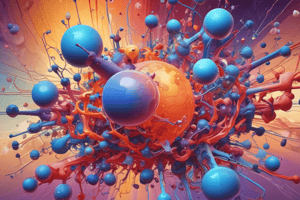Podcast
Questions and Answers
Matter has a distinct volume but no specific ______.
Matter has a distinct volume but no specific ______.
shape
There are 118 ______ including oxygen, nitrogen etc.
There are 118 ______ including oxygen, nitrogen etc.
elements
Matter has no fixed ______ or shape, it will adopt the volume and shape of its container.
Matter has no fixed ______ or shape, it will adopt the volume and shape of its container.
volume
A ______ is a 4th state of matter produced by heating gas or subjecting has to intense electromagnetic fields.
A ______ is a 4th state of matter produced by heating gas or subjecting has to intense electromagnetic fields.
The physical characteristic of plasma is most like a ______.
The physical characteristic of plasma is most like a ______.
The hardness of a substance is measured in the ______ scale.
The hardness of a substance is measured in the ______ scale.
Elements can differ due to ______ (differences in stability due to differing number of neutrons)
Elements can differ due to ______ (differences in stability due to differing number of neutrons)
[Blank] are pure substances that consist of 2 or more chemical elements combined chemically in definite proportions
[Blank] are pure substances that consist of 2 or more chemical elements combined chemically in definite proportions
A ______ is a non-chemical combination of 2 or more pure gas, liquid or solid substances
A ______ is a non-chemical combination of 2 or more pure gas, liquid or solid substances
A ______ is a homogenous mixture
A ______ is a homogenous mixture
Chemistry is the study of ______ and the science of explaining and quantifying observable macroscopic phenomena and properties in terms of microscopic structures and interactions
Chemistry is the study of ______ and the science of explaining and quantifying observable macroscopic phenomena and properties in terms of microscopic structures and interactions
According to Dalton's atomic theory, atoms are ______, indestructible and will always be in motion
According to Dalton's atomic theory, atoms are ______, indestructible and will always be in motion
The ______ of conservation of mass was proposed by Antoine Lavoisier
The ______ of conservation of mass was proposed by Antoine Lavoisier
The law of ______ proportions was proposed by Joseph L. Proust
The law of ______ proportions was proposed by Joseph L. Proust
Flashcards are hidden until you start studying
Study Notes
States of Matter
- Matter exists in one of four states: gas, liquid, solid, and plasma.
- Gas: no fixed volume or shape, adopts the volume and shape of its container.
- Liquid: distinct volume, no specific shape.
- Solid: distinct volume and shape.
- Plasma: produced by heating gas or subjecting it to intense electromagnetic fields, composed of ions (positively and negatively charged particles).
Properties of Matter
- Shape, size, color, mass, volume, ductility, malleability, lustre (shininess), hardness (Mohs scale), boiling point (Celsius or kelvin), melting point, solubility (mass per unit volume), thermal conductivity (W m-1 K-1), and electrical conductivity (A2 s3 m-3 kg-1).
Classification of Matter
- Elements: pure substances that cannot be broken down, all atoms of a chemical element are indistinguishable from each other, most elements are solid in nature.
- There are 118 elements, including oxygen and nitrogen, on the periodic table.
- Elements can differ due to isotopes (differences in stability due to differing number of neutrons).
Compounds
- Compounds are pure substances that consist of 2 or more chemical elements combined chemically in definite proportions.
- Examples include Sodium chloride (NaCl) and water.
Mixtures
- A mixture is a non-chemical combination of 2 or more pure gas, liquid, or solid substances.
- Mixtures can be any of the 3 states and can consist of multiple phases.
- Mixtures can be either homogenous or heterogenous.
- Examples include foam (gas+liquid) and face cream (liquid+solid).
Solutions
- A solution is a homogenous mixture.
- Solutions can be solid, liquid, or gas, but consist of only a single phase.
Chemistry
- Chemistry is the study of matter and the science of explaining and quantifying observable macroscopic phenomena and properties in terms of microscopic structures and interactions.
Dalton's Atomic Theory
- Atoms are indivisible, indestructible, and always in motion.
- Dalton's atomic theory:
- Matter consists of tiny particles called atoms.
- Atoms are indestructible - in chemical reactions, they can be rearranged but not created or destroyed.
- In any sample of a pure element, all atoms are identical in mass and other properties.
- All atoms of different elements differ in mass and other properties.
- When atoms of different elements combine to form a given compound, the constituent atoms in the compound are always present in the same fixed numerical ratio.
Chemical Equations
- Dalton's atomic theory enables us to use a shorthand language to describe chemical reactions - a balanced chemical equation.
- A balanced chemical equation consists of reactants on the left and products on the right, separated by an arrow that indicates change, with elements represented by their chemical symbol, and the physical state following each compound.
The Law of Multiple Proportions
- Whenever two elements form more than one compound, the different masses of one element that combine with the same mass of the other element are in a simple whole-number ratio.
Studying That Suits You
Use AI to generate personalized quizzes and flashcards to suit your learning preferences.




